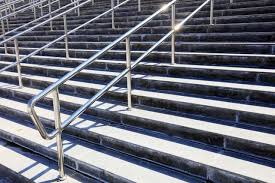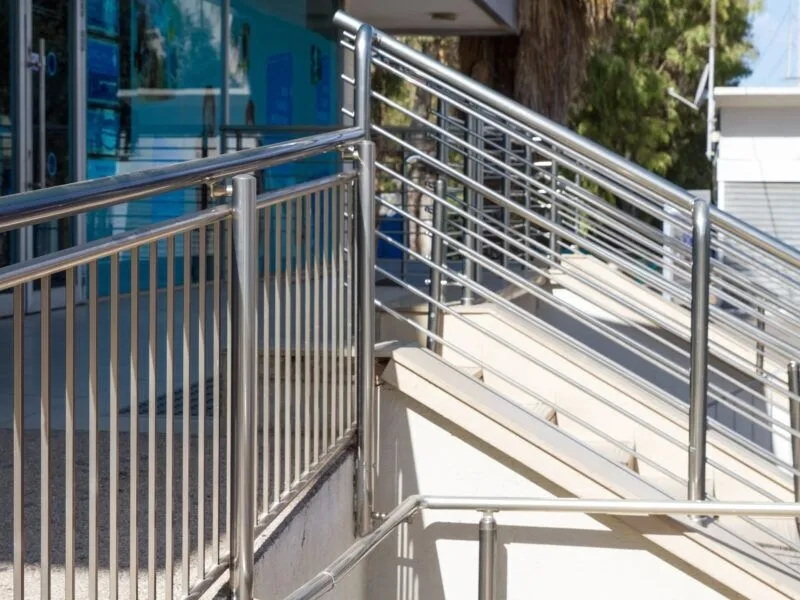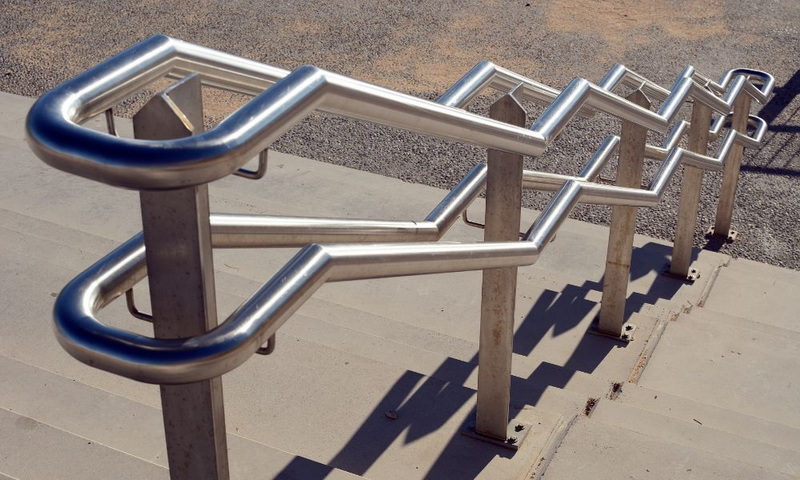English


Views: 222 Author: Tomorrow Publish Time: 2025-07-15 Origin: Site











Content Menu
● Understanding Stainless Steel Grades
>> Grade 304
>> Grade 316
>> Grade 2205
● Key Factors in Stainless Steel Selection
>> Budget
● Additional Considerations for Industrial Applications
>> Welding and Fabrication Quality
>> Environmental Sustainability
● FAQ
>> 1. What are the main types of stainless steel used for industrial guardrails?
>> 2. Why is Grade 316 stainless steel often recommended for outdoor industrial applications?
>> 3. How does the environment impact the choice of stainless steel grade?
>> 4. What are the key considerations beyond stainless steel grade when choosing railings?
>> 5. Can stainless steel railings reduce long-term costs in industrial settings?
Choosing the appropriate stainless steel for industrial guardrails and railings is crucial for ensuring safety, durability, and cost-effectiveness. Several factors influence this selection, including the specific environment, the required strength, maintenance expectations, and budget considerations. Stainless steel is a popular choice due to its strength, corrosion resistance, and aesthetic versatility. This article delves into the important considerations and explains how to make the best choice for industrial guardrails and railings.

Stainless steel comes in various grades, each possessing distinct properties suitable for different applications. The most common grades used for railings are 304, 316, and 2205.
Grade 304 stainless steel is the most frequently used grade, offering good corrosion resistance and affordability. It is well-suited for indoor applications and outdoor settings where exposure to harsh elements like chlorides is minimal. Its composition typically includes 18% chromium and 8% nickel. While easy to maintain and available in shiny finishes, it is not ideal for environments with high salt content or industrial chemicals that can increase corrosion risks.
Grade 316 stainless steel is recognized for its superior corrosion resistance, particularly against chlorides and acidic conditions. This makes it an excellent choice for outdoor, coastal, industrial, and marine applications, including swimming pool railings. It contains a slightly higher nickel content and about 2% molybdenum, which enhances its resistance to corrosion. Although no material is entirely impervious to corrosion, Grade 316 performs well in demanding environments with proper maintenance. In many industrial settings, Grade 316 is often the most cost-effective option due to its minimal maintenance requirements and long service life without the need for paint or coatings.
Grade 2205 is a duplex stainless steel known for its high strength and excellent resistance to stress corrosion cracking. Its robust properties make it suitable for heavy-duty and coastal projects where structural strength and corrosion resistance are both critical. It is becoming increasingly common in applications where both toughness and durability are required, such as chemical processing plants or offshore installations.
While less common, Grade 202 can be an economical alternative to 304, but it offers lower corrosion resistance and is not typically advised for highly corrosive industrial environments. Grade 3CR12 is another option sometimes used due to its good wear resistance, but it lacks the chromium-nickel content typical of more corrosion-resistant grades, and its use should be evaluated carefully by professionals.

Several factors should be thoroughly considered when selecting stainless steel for industrial guardrails and railings. These considerations ensure that the chosen material provides safety, durability, and cost efficiency for the specific application.
The installation environment is a critical determinant in stainless steel selection. Railings in coastal areas or those exposed to saltwater or harsh weather conditions require materials with higher corrosion resistance. Industrial environments, such as those in food, beverage, pharmaceutical, water treatment, wood pulp, and chemical plants, demand specific grades due to the presence of corrosive agents or the need for strict hygiene. For example, stainless steel's non-porous surface facilitates cleaning and hygiene, making it ideal for these sectors. Outdoor and industrial installations are particularly susceptible to pollution and chlorides, which can accelerate deterioration.
If the guardrail is exposed to chemicals, extreme temperatures, or abrasive conditions, these factors must also be incorporated into the selection process to ensure longevity and performance.
The primary purpose of the railing—whether solely for safety or also for aesthetic enhancement—is a key consideration. In industrial settings, safety is paramount. Stainless steel provides high strength, durability, and wear resistance, essential for structural integrity. Correctly specified stainless steel can eliminate the need for coatings, preventing potential contamination issues in sensitive industries. Handrails must meet both aesthetic and structural safety requirements, as rust and corrosion can compromise safety and appearance. Structural codes often mandate specific strength and height requirements for guardrails, and these must be adhered to when selecting the stainless steel grade and design.
While functionality is crucial in industrial applications, the design can still complement the overall structure. Stainless steel offers flexibility in design, allowing for simple or complex customized railings. Finishes such as polished, brushed, or satin can affect both appearance and maintenance needs. A polished finish requires more regular cleaning, whereas brushed or satin finishes are better at concealing scratches and fingerprints. The choice of finish may also impact glare and visibility, which can be an important consideration for safety in industrial spaces.
Additionally, design considerations such as the shape and diameter of the handrail affect usability. Rounded handrails tend to be more ergonomic, while square or rectangular rails may provide a more industrial look but can be less comfortable to grasp.
The level of maintenance expected for the railing system is an important consideration. Stainless steel is generally low-maintenance, especially when the correct grade is chosen for the environment. Properly specified stainless steel can reduce long-term maintenance costs by eliminating the need for frequent cleaning or recoating. However, in highly corrosive environments or heavy industrial settings, routine inspections and occasional cleaning with appropriate agents will extend the life of the guardrails and maintain their appearance.
Edging details, weld quality, and surface finish can also impact maintenance requirements. Smooth welds and well-applied finishes prevent dirt accumulation and corrosion hotspots.
Budget is an important factor in material selection. While stainless steel railings may have a higher upfront cost compared to other materials like wood, aluminum, or galvanized steel, their durability and low maintenance requirements often make them a cost-effective solution in the long run. The cost varies depending on the grade, finish, size, and design complexity. Choosing a stainless steel grade that exceeds the environmental demands may result in unnecessary expenditure, while under-specifying the grade can lead to premature failure and higher replacement costs.
The physical dimensions and form of the railing are also important. Railing height must comply with building codes and meet expected load capacities. The handrail's shape should be comfortable and secure to grip; round handrails are generally easier to grip than square or rectangular ones. The size of the handrail should also be sufficient for a comfortable grip and meet any accessibility regulations.
Additionally, the thickness of the stainless steel tubes or flat bars used in fabrication affects not only strength but also the visual weight and presence of the railing. Heavier gauge materials may be necessary for high-impact industrial zones.

In industrial guardrails, the quality of welding and fabrication is as critical as the stainless steel grade. Poor welding can create weak points leading to failure under stress. Stainless steel requires specific welding techniques and skilled labor to avoid issues like sensitization, which can compromise corrosion resistance. Proper passivation and finishing after welding restore corrosion protection.
Guardrails in industrial environments often face heavy loading or accidental impacts. The chosen stainless steel must maintain its mechanical properties under such conditions. Duplex stainless steels like 2205 offer enhanced strength while retaining good corrosion resistance, making them suitable where high impact resistance is needed.
Industrial railings must comply with local and international standards regarding strength, height, and materials used. For example, OSHA regulations in the US specify minimum requirements for guardrails to protect workers from falls. Ensuring the stainless steel specifications align with these codes is essential for safety and legal compliance.
Increasingly, companies consider environmental impact when selecting materials. Stainless steel is highly recyclable and often contains recycled content, making it an environmentally favorable choice. Longevity and low maintenance further reduce environmental footprint compared to materials requiring frequent replacement or coating.
Selecting the appropriate stainless steel for industrial guardrails and railings requires careful evaluation of various factors. Understanding the properties of different stainless steel grades—such as 304 for general use, 316 for enhanced corrosion resistance in harsh environments, and 2205 for high strength and stress corrosion resistance—is fundamental. Beyond material properties, project-specific considerations including the installation environment, the railing's purpose, design preferences, maintenance expectations, budget constraints, and compliance with standards guide the ultimate decision. Prioritizing safety, durability, and long-term cost-effectiveness through informed material selection and quality fabrication ensures optimal performance for industrial applications.

The primary types of stainless steel used for industrial guardrails are Grade 304, Grade 316, and Grade 2205. Grade 304 is common for indoor or less corrosive outdoor environments, Grade 316 offers superior corrosion resistance for harsh or coastal conditions, and Grade 2205 is a high-strength option suitable for heavy-duty applications.
Grade 316 stainless steel is recommended for outdoor industrial applications due to its superior corrosion resistance, particularly against chlorides and acidic environments. Its enhanced chemical composition, including molybdenum, makes it durable in demanding aquatic or chemical conditions.
The environment impacts the choice by determining exposure to corrosive agents such as salt, chemicals, or pollutants. Harsh or coastal environments require grades with higher corrosion resistance like 316 or 2205, while mild indoor conditions can often use 304.
Other considerations include purpose (safety or aesthetics), location, size and shape, finish, maintenance levels, welding quality, compliance with safety standards, and budget.
Yes, they can. Despite higher initial costs, stainless steel railings offer durability, reduced maintenance, resistance to corrosion, and compliance with safety standards, which together reduce total long-term costs.
Stainless Steel Grades 201 Vs 304: Cost Vs Performance Breakdown
316L Vs 316 Stainless Steel Grades: Which Is Better for Corrosion Resistance?
Comparing Austenitic Vs Martensitic Stainless Steel Grades: What You Need To Know?
Stainless Steel 430 Vs 304: Key Differences Explained for Manufacturers
304 Vs 316 Stainless Steel Grades: Which One Suits Your Project Best?
Stainless Steel Pipes Vs Galvanized Pipes: Durability And Cost Analysis
Comparing Stainless Steel Pipes And PVC Pipes: What You Need To Know?
Stainless Steel Pipes Vs Copper Pipes: Pros And Cons for Industrial Use
Seamless Stainless Steel Pipes Vs Welded Pipes: Key Differences Explained
Stainless Steel Pipes Vs Carbon Steel Pipes: Which One Suits Your Project?
